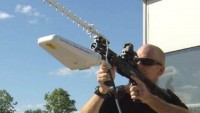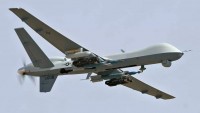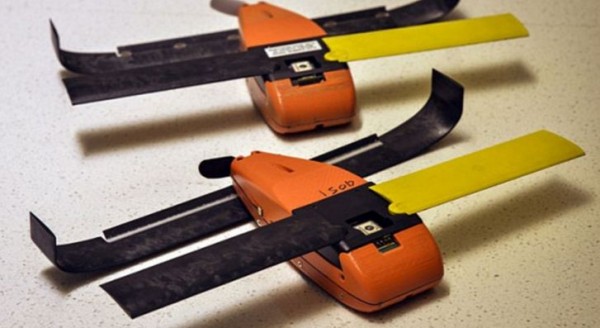US Close to Deploying 'Perdix' Aerial Drone Swarms that Saturate Enemy Air Defenses
| Arthur Dominic Villasanta | | Oct 25, 2016 11:04 PM EDT |
(Photo : SCO) Perdix drones
A once secret Pentagon office took an idea first developed by students at MIT three years ago to develop what might become the U.S. Air Force's best bet for an intelligent swarm of cheap, expendable aerial drone decoys that confuse an enemy's integrated air defense system.
Thoroughly tested for two years in the cold of Alaska and the heat of California, "Perdix" microdrones are ejected from flare dispensers of Air Force aircraft such as the General Dynamics F-16 and the McDonnell Douglas F/A-18 Hornet. They fall to earth, deploy their folded wings and assume a formation to attain the goal they're programmed to accomplish.
Like Us on Facebook
The job of these decoys is to confuse enemy radar systems, diverting attention away from manned air superiority fighters or attack jets. An F-16 has 30 flare dispensers and can, therefore, carry 30 Perdixes.
Perdixes are 3D-printed using Kevlar and carbon fiber. Each drone comes with spring-loaded carbon fiber wings; a low-drag fiberglass fuselage; a custom pusher propeller and a lithium polymer battery pack.
Each drone is about the size of an iPhone 6 and weighs some 2.2 kilograms. It's built using commercial off-the-shelf components.
The microdrone was created and developed by MIT students. The Pentagon's once secret Strategic Capabilities Office (SCO) liked the idea and repurposed a drone intended for civilian scientific experiments into a drone that fights wars.
SCO Director William Roper, a physicist, began Perdix testing in 2014. SCO's goal is to make the Perdix system much more effective and more cost-friendly compared to the expensive and very much larger ADM-160 MALD (Miniature Air-Launched Decoy). MALD is 2.4 meters long.
"They (Perdixes) are expendable and fly low as a surveillance asset. You can have a lot of them for a saturation approach. Saturating has an advantage over the thing it has to defend against. Its defender has to take more time and money to defend against it," said Roper.
The Defense Department agrees.
"Just imagine an airplane going in against an IAD (Integrated Air Defense) system and dropping 30 of these out that form into a network and do crazy things," said Robert Work, Deputy Secretary of Defense.
"We've tested this. We've tested it and it works."
The Pentagon has been testing swarms of drones designed to jam enemy air defenses; blanket areas with small sensors and attack targets.
TagsPerdix, aerial drones, MIT, Strategic Capabilities Office, William Roper, Robert Work, microdrone
©2015 Chinatopix All rights reserved. Do not reproduce without permission
 ISIS Aerial Drone Shot Down in Iraq by Handheld US Electronic Drone Killing Gun
ISIS Aerial Drone Shot Down in Iraq by Handheld US Electronic Drone Killing Gun US Air Force MQ-9 Reaper Hunter-Killer Drone being Made Deadlier
US Air Force MQ-9 Reaper Hunter-Killer Drone being Made Deadlier First DIUx Contracts will Develop Smarter Land, Sea and Aerial Drones
First DIUx Contracts will Develop Smarter Land, Sea and Aerial Drones Drones are the Future of Undersea Warfare in the US Navy
Drones are the Future of Undersea Warfare in the US Navy US Aerial Drones from Djibouti Hunting Houthi Missile Battery that Attacked USS Mason
US Aerial Drones from Djibouti Hunting Houthi Missile Battery that Attacked USS Mason
EDITOR'S PICKS
-

Did the Trump administration just announce plans for a trade war with ‘hostile’ China and Russia?
-

US Senate passes Taiwan travel bill slammed by China
-

As Yan Sihong’s family grieves, here are other Chinese students who went missing abroad. Some have never been found
-

Beijing blasts Western critics who ‘smear China’ with the term sharp power
-

China Envoy Seeks to Defuse Tensions With U.S. as a Trade War Brews
-

Singapore's Deputy PM Provides Bitcoin Vote of Confidence Amid China's Blanket Bans
-

China warns investors over risks in overseas virtual currency trading
-

Chinese government most trustworthy: survey
-

Kashima Antlers On Course For Back-To-Back Titles
MOST POPULAR
LATEST NEWS
Zhou Yongkang: China's Former Security Chief Sentenced to Life in Prison

China's former Chief of the Ministry of Public Security, Zhou Yongkang, has been given a life sentence after he was found guilty of abusing his office, bribery and deliberately ... Full Article
TRENDING STORY

China Pork Prices Expected to Stabilize As The Supplies Recover

Elephone P9000 Smartphone is now on Sale on Amazon India

There's a Big Chance Cliffhangers Won't Still Be Resolved When Grey's Anatomy Season 13 Returns

Supreme Court Ruled on Samsung vs Apple Dispute for Patent Infringement

Microsoft Surface Pro 5 Rumors and Release Date: What is the Latest?










